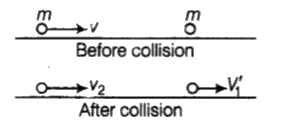A billiard ball moving with a speed of 5m/s collides with an identical ball, originally at rest. If the first ball stop dead after collision, then the second ball will move forward with a speed of:
10ms−1
5ms−1
2.5ms−1
1.0ms−1
The correct Answer is:B
Step by step video, text & image solution for A billiard ball moving with a speed of 5 m//s collides with an identical ball, originally at rest. If the first ball stop dead after collision, then the second ball will move forward with a speed of: by Physics experts to help you in doubts & scoring excellent marks in Class 12 exams.
Topper's Solved these Questions
Similar Questions
A ball of mass mm, moving with a speed 2υ0, collides inelasticaly (e>0) with an identical ball at rest. Show that (a) For head - on collision, both the balls move forward.
(b) For a genergcollision, the angle between the two velocities of scattered balls is less that 90∘.View SolutionA massive ball moving with speed v collides with a tiny ball by negligible mass. The collision is elastic. Find the speed with which the second tiny ball will move.
View Solution
Knowledge Check
- Question 1 - Select One
A billiard ball moving with a speed of 5m/s collides with an identical ball, originally at rest. If the first ball stop dead after collision, then the second ball will move forward with a speed of:
A10ms−1B5ms−1C2.5ms−1D1.0ms−1 - Question 2 - Select One
A billiard ball moving at a speed 2m/s strikes an identical ball initially at rest, at a glancing blow. After the collision one ball is found to be moving at a speed of 1m/s at 60∘ with the original line of motion. The velocity of the other ball shall be -
A(3)12m/sat30∘ to the original direction.B1m/sat60∘ to the original directionC(3)1/2m/sat60∘ to the original directionD1m/sat30∘ to the original direction - Question 3 - Select One
A heavy ball moving with speed v collides with a tiny ball. The collision is elastic, then immediately after the impact, the second ball will move with a speed approximately equal to
A(a) vB(b) 2vC(c) v2D(d) v3
A ball P moving with a speed of v ms collides directly with another identical ball Q moving with a speed 10ms' in the opposite direction. P comes to rest after the collision. If the coefficient of restitution is 0.6 the value of v is
View SolutionOn a frictionless surface, a ball of mass m moving at a speed v makes a head on collision with an identical ball at rest. The kinetic energy of the balls after the collision is 3/4th of the original. Find the coefficient of restitution.
View SolutionA ball moving with a speed of 9m/s strikes an identical ball at rest, such that after the collision, the direction of each ball makes an angle of 30∘ with the original line of motion. Find the speeds of the two balls after collision.
View SolutionA ball of mass m moving with a speed v makes a head on collision with an identical ball at rest. The kinetic energy after collision of the balls is three fourth of the original kinetic energy. The coefficient of restitution is
View SolutionChoose the most appropriate option.
A ball of mass m moving at a speed v makes a head on collision with an identical ball at rest. The kinetic energy at the balls after the collision is 3/4th of the original. What is the coefficient of restitution?
 View Solution
View Solution

